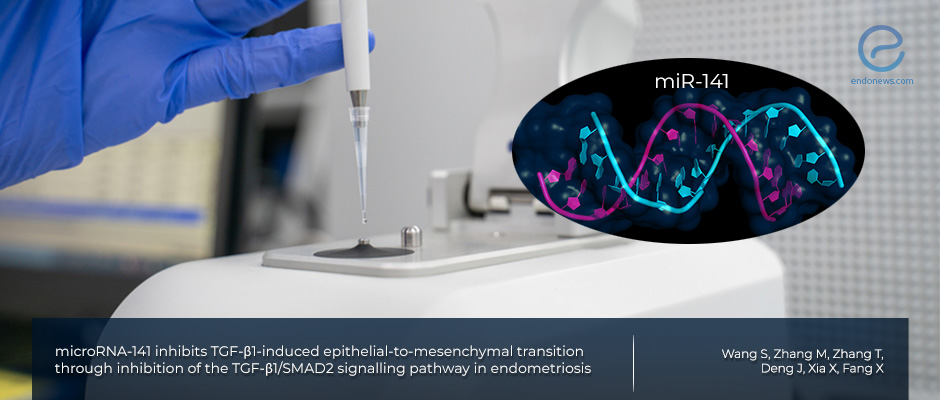Role of miR-141 in endometriosis
Feb 5, 2020
miR-141: a novel player in the regulation of EMT in endometriosis
Key Points
Highlights:
- miR-141 targets TGF-β1/SMAD2 signaling pathway, so when induced, a decrease of TGF-β1 reduces the epithelial-mesenchymal transition in endometriosis
Importance:
- Data from this study highlight the importance of miRNAs in the regulation of endometriosis and emphasize the importance of EMT in endometriosis development
What’s done here?
- Using human endometrial samples and endometrial cancer cell line ISK, expression of EMT markers and activation of TGF-β1/SMAD2 was investigated, and the role of miRNA-141 was explored as the regulator of this pathway.
Key results:
- The expression levels of TGF-β1, vimentin, and p-SMAD2 were increased while the expression level of E-cadherin was decreased in eutopic and ectopic endometrial tissues compared to normal tissues.
- The miR-141 expression is decreased in eutopic and ectopic endometrial tissues compared to normal tissues.
- miR-141 targeted the TGF-β1/SMAD2 pathway resulting in reduced EMT in ISK cells.
Limitations of the study:
- Lack of in vivo experiments to validate the in vitro data and establish the clinical relevance.
Lay Summary
MicroRNAs (miRNAs) are short (18–24 nucleotides) endogenous non-coding RNAs that regulate a broad range of signaling pathways. They bind to specific sequences resulting in mRNA degradation and protein inhibition. Deregulation of miRNAs is associated with the development of many disease conditions, one of which is endometriosis.
Epithelial-to-mesenchymal transition (EMT), which is considered as one of the hallmarks of cancer metastasis is the process of conversion of epithelial cells to mesenchymal cells, which increase the motility and invasiveness of cancer cells and enhance their stem cell-like characteristics. EMT can be stimulated by many molecules, TGF-β1 being one of them.
A recent study demonstrated that miR-141 expression was decreased in patients with endometriosis without explaining its functional role in the disease. This study published by the same group in Archives of Gynecology and Obstetrics, and authored by Wang et al., further investigated the role of miR-141 in endometriosis and showed that miR-141 prevents EMT in endometrial cancer cell lines by targeting TGF-β1 and SMAD2 phosphorylation. By comparing the eutopic and ectopic endometrial tissues to normal tissues, they first demonstrated the increased expression levels of TGF-β1, vimentin, and p-SMAD2 and decreased expression level of E-cadherin, which indicates increased EMT in endometriosis. They then showed that the activation of the TGF-β1/SMAD2 signaling pathway enhanced EMT in ISK cells. Finally, they investigated whether there was an association between decreased expression of miR-141 and increased activity of the TGF-β1/SMAD2 signaling pathway in endometriosis. They assessed this hypothesis by overexpressing miR-140 in ISK cells and checking the expression of EMT-related proteins, and migration and invasion levels in these cells. Overexpression of miR-141 in ISK cells resulted in:
- Decreased expression of TGF-β1, SMAD2, and vimentin.
- Increased expression of E-Cadherin
- Decreased TGF-β1-induced invasion
The study concluded that miR-141 is involved in EMT in endometriosis and acts as an inhibitor of the TGF-β1/SMAD2 signaling pathway, which suggests a regulatory role for miR-141 in disease progression. More importantly, miR-141 was suggested as a potential diagnostic tool for the detection of endometriosis, pending further investigation.
Research Source: https://www.ncbi.nlm.nih.gov/pubmed/31903498
miRNAs endometriosis EMT

